Ear Aesthetics
What is Ear Aesthetics?
Ears, whose main function is hearing, can appear in unusual shapes. The most common external ear deformation is the so-called prominent ear, where the ears curve forward. Prominent ears are often perceived as “ears that are bigger than they should be”. However, this is not very true. There is actually no difference in ear size between a person with prominent ears and a person with normal ears. The problem is only related to the shape of the ear cartilages. The fact that the folds of the auricle are not fully formed during congenital development is popularly called prominent ear. With prominent ear operation, we reconstruct the unformed folds of the ear with surgical technique.

Suitable Candidates for Ear Aesthetics
Ear surgery is a surgical procedure that aims to correct abnormalities in the shape of the ear, usually for aesthetic or functional reasons. Suitable candidates for this procedure usually include several conditions. Firstly, the person must be in good general health. Suitable candidates for ear surgery are those who are uncomfortable with the shape or size of the ears, who want to correct congenital or trauma-induced deformities, or who have problems that affect hearing function. Candidates should undergo a plastic surgeon’s evaluation and clearly articulate their expectations before deciding to undergo the procedure. By assessing the person’s physical health and aesthetic goals, the surgeon can determine the most appropriate treatment plan.
Contact Us!
Ear Aesthetic Recovery Process
The healing process after ear surgery is usually gradual and individualized. Mild swelling and bruising may be seen in the first few days after surgery, but these symptoms decrease over time. It is important to carefully care for the surgical site and use the medications recommended by the doctor regularly. Bandages and supportive materials can be used in the first weeks. Physical activities may be limited in the first few weeks, especially to prevent trauma to the head. Full recovery may take several weeks to several months. It is important to attend follow-up appointments regularly and follow the doctor’s recommendations. Given the individual differences in the healing process, carefully following the post-surgical guidelines can help patients achieve the best results.

Frequently Asked Questions
Usually no. Ear aesthetics are usually performed under local anesthesia. However, for special cases, general anesthesia can also be used depending on the preference of the surgeon and the patient.
